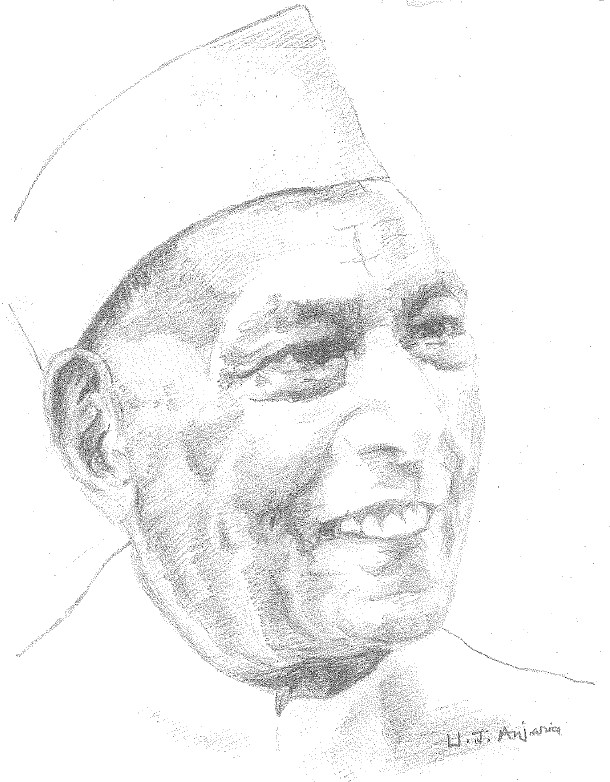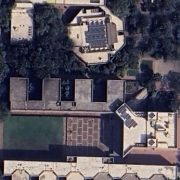OUR FOUNDERS AND BUILDERS
Kasturbhai Lalbhai and IIMA
Kasturbhai Lalbhai (1894-1980) was a pioneering Indian industrialist and one of the founding members of IIMA. Outside business, he participated in the Swadeshi movement (self-reliance and self-sufficiency movement that was part of the Indian independence struggle) in the 1930s and co-founded the Ahmedabad Education Society in 1936. He served on the Board of Governors of IIMA for several years and, as Chairperson of the Buildings Committee of the Board, steered the development of the campus in the Institute’s early years. The Institute named its Management Development Centre after him, and hosts the Kasturbhai Lalbhai Chair Professorship of Entrepreneurship. In this article, Prafull Anubhai, who has been associated with the Institute for decades, first as a participant in one of its early programmes, the Programme for Young Executives, and later as a visiting faculty, and a member of the IIMA Society and the IIMA Board of Governors, highlights Kasturbhai’s role in building IIMA.
Kasturbhai Lalbhai played a pivotal role in the founding of IIMA and its development. It was transformational and he played it without seeking any publicity, drawing attention to himself, or making grandiose statements. His contribution was like a glacier: 10% visible, 90% intangible.
Caption: Sketch of Kasturbhai Lalbhai by Urmil. J. Anjaria, a former staff member of IIMA
Getting IIM to Ahmedabad
On February 5, 1955, T. T. Krishnamachari (T.T.K.), India’s Minister of Commerce, gave the keynote address at the first management conference of the Ahmedabad Textile Industry’s Research Association (ATIRA). At that time, Vikram Sarabhai was the director of ATIRA and Kasturbhai Lalbhai was the Chairman. T.T.K. stated that he had been appointed Chairman of a committee to establish an all-India management education institution. The committee’s work culminated in a report by Dean George Robbins of the University of California, Los Angeles, brought out in December 1959. As the commercial capital of the country, Mumbai was the obvious choice for the new institution. In the meanwhile, Gujarat state was formed in 1960, and Dr Jivraj Mehta was named the first Chief Minister. He was a very enlightened and progressive politician. Vikram Sarabhai wanted the proposed institute to be located in Ahmedabad, and he and Kasturbhai decided to enlist the support of Dr Mehta.
The odds were heavily stacked against Ahmedabad. But Kasturbhai was the Chairman of the Ahmedabad Education Society, which had established several leading educational institutions in Ahmedabad and also promoted the Physical Research Laboratory (PRL), the National Institute of Design (NID), and ATIRA. Kasturbhai’s track record of establishing institutions, and his high stature among the state’s political leaders, bureaucracy and fellow industrialists and businessmen, gave a huge fillip to the claim.
Robbins had underlined the need for collaboration among business, government, and educationists. The trio sensed an opportunity in this observation. Dr Mehta promptly committed 65 acres of prime land, Kasturbhai offered to underwrite the cost of buildings on behalf of the local business community, and Vikram Sarabhai mobilized support from the professional community. Together they swung the decision in Ahmedabad’s favour.
The following observation by Professors Hill, Haynes, and Baumgartel provides a succinct summary of the outcome. The choice was due to ‘…the promise of strong private sector support in the Ahmedabad area. In any event, such support did materialize in the form of an excellent physical plant, including a sufficiency of on-campus faculty housing. In contrast, IIMC still remains in what are now grossly inadequate ‘temporary’ quarters.’1
Adopting the PPP mode at IIMA
In all the institutions he founded and developed, Kasturbhai had mobilized the local community. The trust this engendered was in no small measure responsible for the implementation of a model that had only been hinted at by Robbins. Long before the PPP (Public private partnership) model became popular, the first genuine and highly effective PPP was successfully formed in India in 1961 with the Government of India (GoI), the Government of Gujarat and industry as partners, and the Ford Foundation (FF) acting as a facilitator. This feat was unique and remarkable in many ways.
Selecting the Architect and developing a world-class infrastructure
Kasturbhai had pledged funds for building construction as part of the agreement with the Government. The initial amount committed was the Rs 30 lakh that had been given as an estimate in the Robbins report. This commitment gave IIMA the freedom to choose its architect and not follow Government of India rules. Fundamentally, this altered the process of creation of the infrastructure. But for this farsighted arrangement the campus would have been a PWD (Public Works Department) jumble. It also sowed the seeds of institutional autonomy.
Vikram Sarabhai and Kasturbhai wanted an international architect for the project. Kasturbhai knew Balkrishna V. Doshi2 as a budding architect. He consulted Doshi who suggested Louis Kahn. Kasturbhai asked Doshi, ‘Would you select him (Kahn) for your own project?’ Doshi has noted, ‘That concluded the proposal…My suggestion to have Lou [Louis Kahn] design the IIM campus was accepted on the condition that I should represent both the client and the architect. In short, it would be my responsibility to see the project through to completion’ (Architectural Legacies of Ahmedabad: Canvas of Modern Masters by B. V. Doshi, p.17).
A wonderful dialogue developed between Kahn and Kasturbhai. While he respected Kahn, he was not overwhelmed by his reputation. Once, both were reviewing Kahn’s plans for the main academic block. Kahn had provided for a canteen in the same block. Kasturbhai immediately reacted by saying that it was not right. Indian food is spicy and has strong aromas. Having the canteen near the classrooms would ‘pollute’ the ambience. Kahn accepted this. Such insights were noted by Kahn, who observed, ‘Mr. Lalbhai (Kasturbhai) is one of the greatest natural architects I have encountered.’
Kasturbhai embodied the values of simplicity, austerity, frugality, functionality, and accountability. These were shared by Kahn. This simplicity and frugality almost bordering on asceticism are clearly visible in the design of the IIMA buildings. The IIMA campus bears the stamp of these outstanding minds-the rationality of a scientist (Sarabhai), the practical wisdom of a home-grown entrepreneur (Kasturbhai), and the spirituality of a ‘philosopher of space’ (Kahn).
Kasturbhai was the Chairman of the Building Committee for seventeen years. It is difficult to imagine how a man of his stature, who headed such a large industrial empire, and ran so many public institutions accepted this position, found time, and discharged his responsibilities with such efficiency and effectiveness. He could not have performed his duties with greater passion and dedication if he were supervising the construction of his own house!
‘Institution First’ – Turning down Chairmanship of IIMA
Kasturbhai was offered the Chairmanship of IIMA on several occasions. Each time, he steadfastly refused. Around the same time, he had accepted the Chairmanship of IIT, Mumbai and served it for nearly ten years. He had also accepted the Chairmanship of the Building Committee of IIMA. This only made his non-acceptance of IIMA Chairmanship puzzling. He reasoned that coming as he did from Ahmedabad, his acceptance of the Chairmanship of IIMA would make IIMA appear more like a local institution than a national one. That is why he declined the offer. He put the Institute first, and himself second.
His stamp on BoG deliberations
In one of the early meetings of the Board of Governors (BoG), the issue of MBA degree-granting status was being discussed. At that stage, the issue was of great importance to the Institute. HBS had raised the issue of degree conferment right at the beginning. Attracting good students was essential to the building of a good institute. Vikram Sarabhai and later Ravi Matthai pressed for the degree-granting status at the Board meeting, but the GoI members were dithering. The alternatives suggested would have led to the direct political/bureaucratic oversight of the Institute. The BoG debate was serious but inconclusive. Kasturbhai stated that we should make do without the degree-granting status and there was a finality about his position. The matter was settled. As we look back, it was a farsighted and prescient decision. It averted academic autonomy being compromised. Soon IIMA’s ‘PGP’ (the Postgraduate Programme in Management) was accorded higher status than ‘MBA’ in the job market!
Kasturbhai was a pioneering educational entrepreneur, a farsighted leader and a no-nonsense decision-maker!
1 Hill, T. M., Haynes, W. W., & Baumgartel, H. J. (1973). Institution building in India: A study of international collaboration in Management Education. Boston: Harvard University, Graduate School of Business Administration, Division of Research, p. 16.
2 Balkrishna V. Doshi (1927-2023), a well-known Indian architect, and winner of the Pritzker Architecture Award, was associated with the designs of many famous structures, including the campuses of IIMA and Indian Institute of Management Bangalore.



